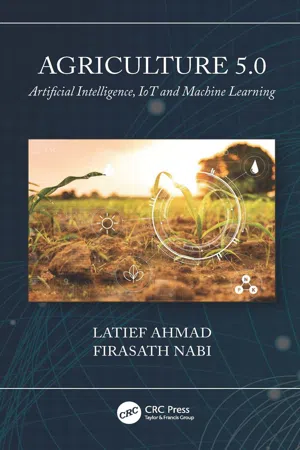
Agriculture 5.0
Artificial Intelligence, IoT and Machine Learning
- 224 pages
- English
- ePUB (mobile friendly)
- Available on iOS & Android
About this book
Agriculture 5.0: Artificial Intelligence, IoT & Machine Learning provides an interdisciplinary, integrative overview of latest development in the domain of smart farming. It shows how the traditional farming practices are being enhanced and modified by automation and introduction of modern scalable technological solutions that cut down on risks, enhance sustainability, and deliver predictive decisions to the grower, in order to make agriculture more productive. An elaborative approach has been used to highlight the applicability and adoption of key technologies and techniques such WSN, IoT, AI and ML in agronomic activities ranging from collection of information, analysing and drawing meaningful insights from the information which is more accurate, timely and reliable.It synthesizes interdisciplinary theory, concepts, definitions, models and findings involved in complex global sustainability problem-solving, making it an essential guide and reference. It includes real-world examples and applications making the book accessible to a broader interdisciplinary readership.
This book clarifies hoe the birth of smart and intelligent agriculture is being nurtured and driven by the deployment of tiny sensors or AI/ML enabled UAV's or low powered Internet of Things setups for the sensing, monitoring, collection, processing and storing of the information over the cloud platforms. This book is ideal for researchers, academics, post-graduate students and practitioners of agricultural universities, who want to embrace new agricultural technologies for Determination of site-specific crop requirements, future farming strategies related to controlling of chemical sprays, yield, price assessments with the help of AI/ML driven intelligent decision support systems and use of agri-robots for sowing and harvesting. The book will be covering and exploring the applications and some case studies of each technology, that have heavily made impact as grand successes. The main aim of the book is to give the readers immense insights into the impact and scope of WSN, IoT, AI and ML in the growth of intelligent digital farming and Agriculture revolution 5.0.The book also focuses on feasibility of precision farming and the problems faced during adoption of precision farming techniques, its potential in India and various policy measures taken all over the world. The reader can find a description of different decision support tools like crop simulation models, their types, and application in PA.
Features:
- Detailed description of the latest tools and technologies available for the Agriculture 5.0.
- Elaborative information for different type of hardware, platforms and machine learning techniques for use in smart farming.
- Elucidates various types of predictive modeling techniques available for intelligent and accurate agricultural decision making from real time collected information for site specific precision farming.
- Information about different type of regulations and policies made by all over the world for the motivation farmers and innovators to invest and adopt the AI and ML enabled tools and farming systems for sustainable production.
Frequently asked questions
- Essential is ideal for learners and professionals who enjoy exploring a wide range of subjects. Access the Essential Library with 800,000+ trusted titles and best-sellers across business, personal growth, and the humanities. Includes unlimited reading time and Standard Read Aloud voice.
- Complete: Perfect for advanced learners and researchers needing full, unrestricted access. Unlock 1.4M+ books across hundreds of subjects, including academic and specialized titles. The Complete Plan also includes advanced features like Premium Read Aloud and Research Assistant.
Please note we cannot support devices running on iOS 13 and Android 7 or earlier. Learn more about using the app.
Information
1 | Introduction to Precision Agriculture |
1.1 History of Precision Agriculture and Its Global Adoption
Willingness is directly proportional to the availability of information about PA, precision in information, and the probability of positive results.
1.2 Precision Agriculture – Introduction
1.2.1 Foreign Perspective
1.2.2 Indian Perspective
Table of contents
- Cover
- Half Title
- Title Page
- Copyright Page
- Contents
- Authors
- List of Abbreviations
- Chapter 1 Introduction to Precision Agriculture
- Chapter 2 Smart Intelligent Precision Agriculture
- Chapter 3 Adoption of Wireless Sensor Network (WSN) in Smart Precision Agriculture
- Chapter 4 IoT (Internet of Things) Based Agricultural Systems
- Chapter 5 AI (Artificial Intelligence) Driven Smart Agriculture
- Chapter 6 Machine Learning (ML) Driven Agriculture
- Chapter 7 Data-Driven Smart Farming
- Chapter 8 Decision-Making and Decision-Support Systems
- Chapter 9 Agriculture 5.0 – The Future
- Chapter 10 Social and Economic Impacts
- Chapter 11 Environmental Impact and Regulations
- Index